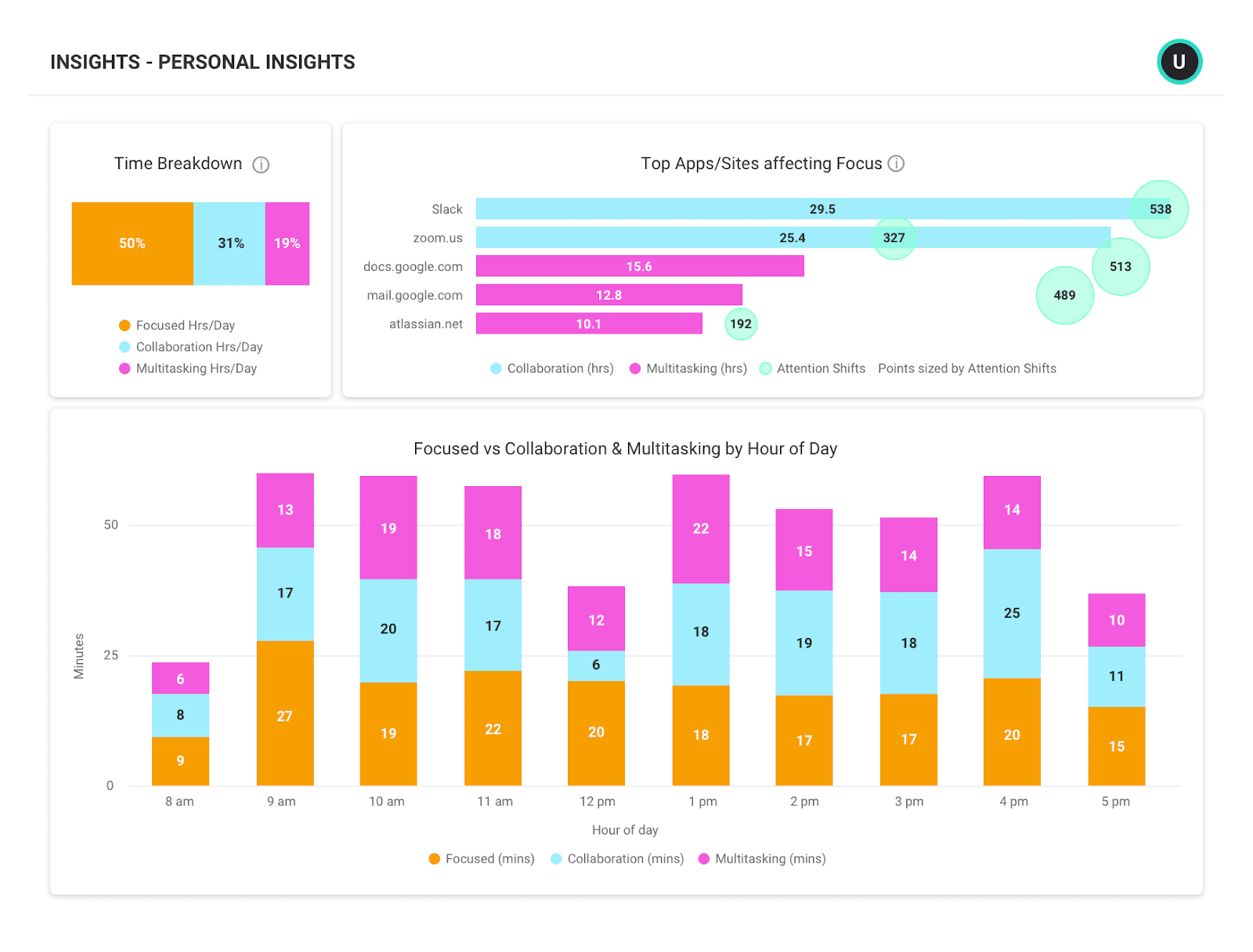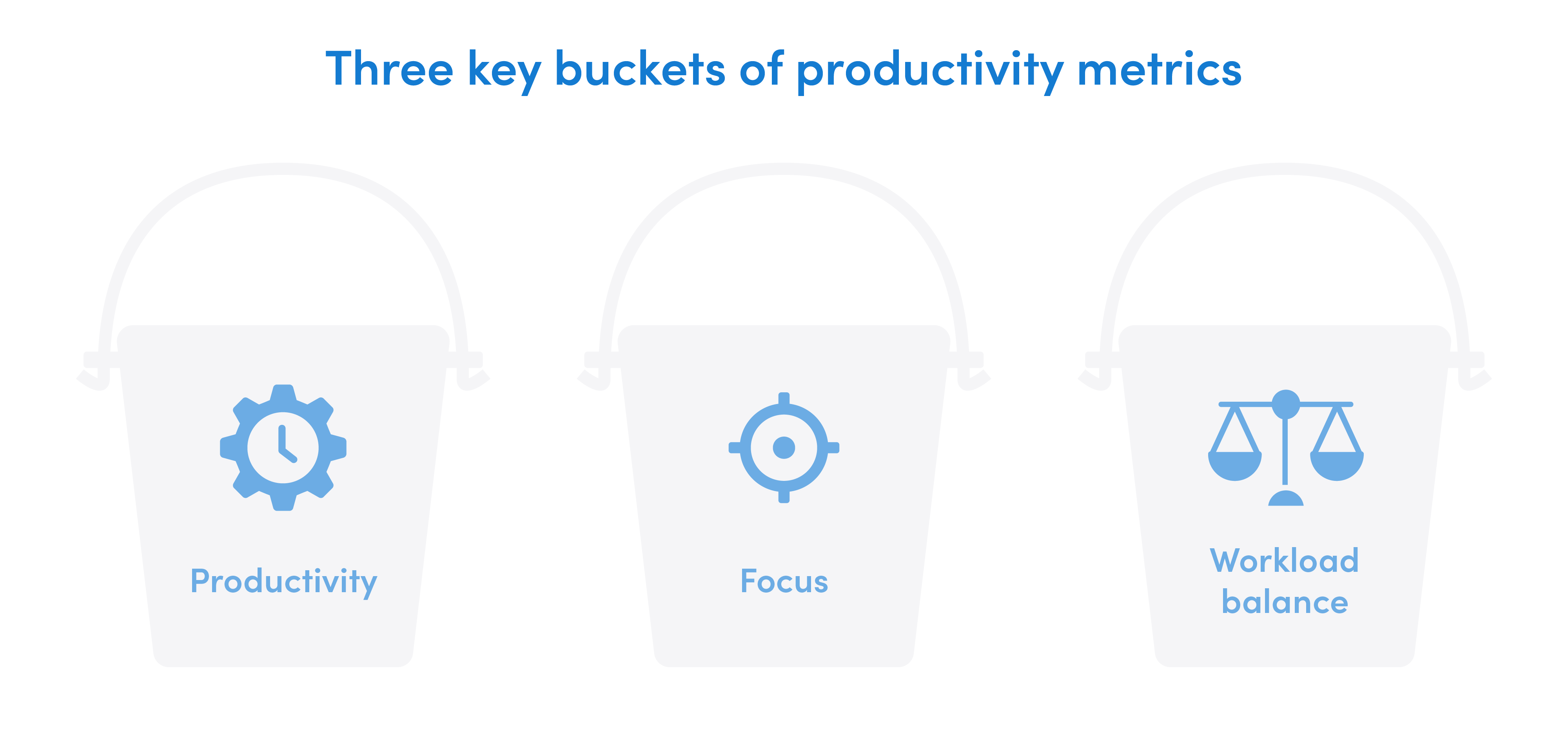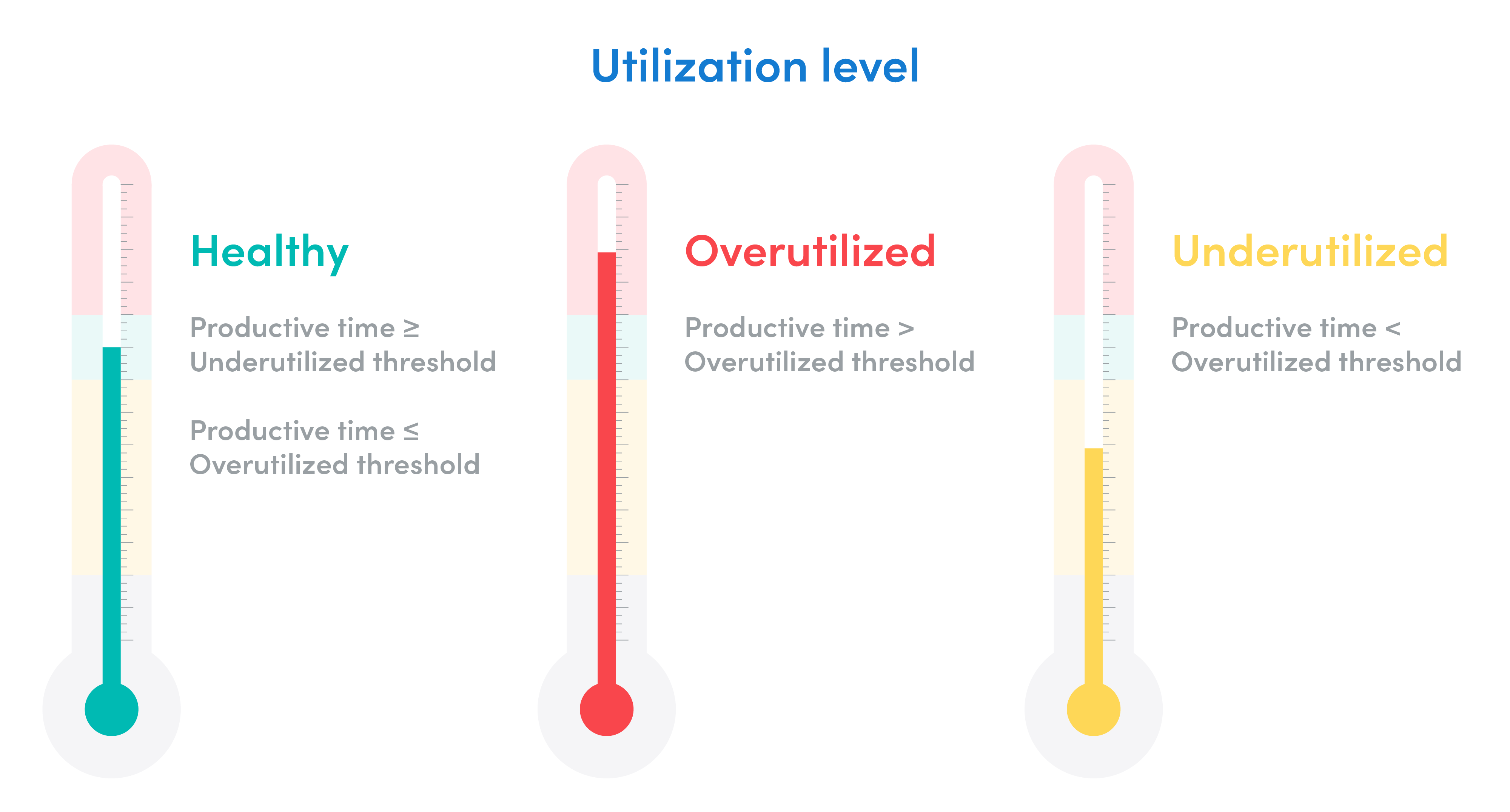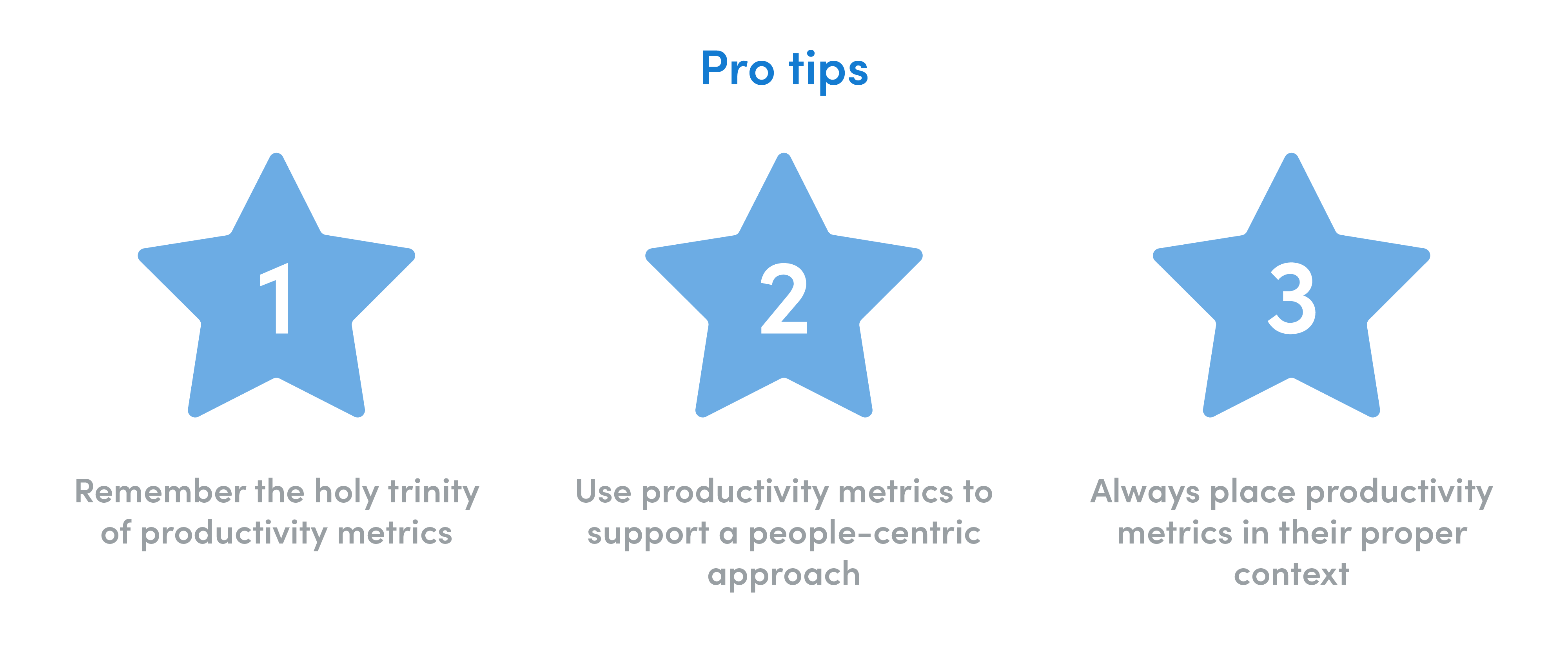Show Hide Topic Menu
- Productivity Management
- How it Works
- Learn how
- Employee Productivity:
A Modern Approach - Productivity Monitoring with Transparency
- 3 Productivity Metrics to Help Your Team Work Wiser
- Productivity Measurement at Your Company
- Tracking Productivity Through Monitoring Software
- Productivity Management for Lasting Change
- Team Productivity Through Workforce Analytics
- What Workforce Productivity Can Teach Leadership
- Productivity vs. Efficiency: Differences and Formulas
- 10 Workplace Productivity Statistics Leaders Should Know
- Employee Productivity:
At ActivTrak, we talk a lot about the importance of taking a holistic, person-driven approach to productivity management. We believe productivity is at its best when it’s coupled with a healthy culture, engaged employees, and sustainable wellness levels. Unfortunately, traditional approaches to product management tend to take a different approach, with managers and team leaders placing so much emphasis on the numbers — how many hours were logged today, how many deadlines were met, etc. — that they do a disservice to the people producing those numbers.
Of course, taking a people-centric approach to productivity management doesn’t mean you should omit productivity metrics altogether. The best approach — one that focuses on supporting individual employees and helping them succeed — uses good data and relevant performance metrics to improve the team’s productivity.
In this article, we’ll explain what productivity metrics are, why they’re important, and how you can measure productivity on a workforce and employee level. We’ll also talk about the most important productivity metrics and show you how each one can help you boost employee productivity, giving you the insights you need to support your teams as they work to achieve your business goals.
Where do you want to start?
- What Are Productivity Metrics?
- The Importance of Productivity Metrics
- Using Productivity Metrics To Increase Business Results
- How Do You Measure Productivity?
- Key Productivity Metrics You Should Be Measuring
- Does Every Business Need Productivity Metrics?
- Moving Beyond Productivity Metrics to Boost Productivity and Performance
What Are Productivity Metrics?
Productivity metrics are measures that quantify how employee activities contribute to the company’s goals and their individual performance in several areas. These employee productivity metrics are also helpful insights to track, manage, and support your employee’s performance.
Productivity metrics should give employers the confidence to make decisions that benefit both their business and employee wellbeing.
Defining Productivity
Productivity is generally defined as the degree to which outputs are efficiently achieved through maximizing inputs in a given amount of time. Outputs are unique to each enterprise, but they include any service or product you provide to the market. Inputs or “productivity enablers” tend to be similar across enterprises, encompassing things like teamwork, tools efficiency, workflows and innovation.
At ActivTrak, we believe that the new, broader definition of productivity introduces the well-being of the resources leveraged to produce the outcome. It takes into account how the outcomes are achieved. Relying solely on outputs rarely, if ever, gives you a complete picture of labor productivity. In the modern enterprise, productivity measurement needs to look beyond outputs and seriously consider the input factors — specifically the employees, workflows, and technologies — that lead to those outputs.
Defining Metrics
A metric is a meaningful measurement taken over a period of time that communicates vital information about a process or activity, leading to fact-based decisions. Metrics are usually specialized by the subject area. Productivity metrics should be constructed to encourage productivity improvement, effectiveness, efficiency, and appropriate levels of internal controls. We can no longer ignore concepts like burnout, disconnectedness, and mental health.
Characteristics of a good metric:
- Drives appropriate action
- Simple, understandable, logical and repeatable
- Clearly defined
- Data is collectible
- Shows how organizational goals and objectives are being met
- Can be combined with a people-centric productivity approach
The Importance of Productivity Metrics
Without productivity metrics and key performance indicators (KPIs) helping you generate data-driven insights into employee productivity, your efforts to boost productivity levels would be based on guesswork or observations. Even if you make an effort to get insights into team members’ experiences through team syncs, status updates, or performance reviews, you are still unlikely to get the real-time, authentic insight you need. That’s why we believe the only effective way to spark lasting change is to collect and analyze important productivity metrics on an employee and workforce level that you can combine with a people-centric approach.
Using Productivity Metrics To Increase Business Results
Many companies use productivity metrics to measure their own performance standards and to assess their progress. However, when businesses measure productivity for its sustainability, they can elevate their approach to managing individuals and entire organizations. By accurately measuring productivity, a business can significantly increase its revenue and take a winning position in its industry. Here are some ways productivity metrics help with improving business results:
- Assistances in conducting efficient operations
- Ensures proper allocation and time management
- Helps identify weak areas in the business
- Provides timely feedback to better align efforts
- Increases the number of products and services
- Understanding of employee burnout risk
Productivity metrics identify and correct potential problems and any anomalies in organizational activities, preventing and avoiding losses to customers and the business itself.
How Do You Measure Productivity?
Productivity can be measured by dividing Total Outputs by Total Inputs, although this is only a high-level calculation without consideration for unique business factors. For most companies, measuring productivity is never as simple as using the output/input model. The variety of workforce productivity metrics and methods used reflects the fact that every business has different goals. In simple terms, measuring productivity is a three-part process. A business needs to choose the productivity metrics that align with its business goals. Second, businesses need to calculate those productivity metrics. Along with measuring and assessing productivity, businesses must also consider the employees’ wellness, and ensuring that they feel heard and empowered is integral to business success.
To calculate the productivity metrics, businesses need to determine the desired outcome or output. Once they establish this they must determine what business activities are needed to achieve the desired results. Businesses must then be able to properly measure the results to determine if these specific business activities lead to the desired results. Measuring employee productivity can bring vital changes to how a company operates. It also empowers businesses to work wiser and thrive. Next, we’ll cover some of the important productivity metrics.
Key Productivity Metrics You Should Be Measuring
Every business across every industry, from the smallest startups to the biggest enterprises, has specific needs that dictate which metrics are most relevant to measure productivity on a workforce or employee level. While it’s always important to focus on the KPIs for your business, we believe that every enterprise, no matter its number of employees or industry, should collect productivity metrics in these three core buckets:
Productivity Metrics
Productivity metrics can cover a huge number of factors, and some metrics should be observed on an employee and workforce level. If you’re new to measuring productivity, start with these essential metrics:
Productive Hrs/Day:
This metric measures the average amount of time a user spends on applications classified as “productive,” including both active and passive time. It’s calculated by dividing (productive time) / (# of users).
Productivity Efficiency Percentage:
This metric reflects the percentage of productive time in relationship to total time. It’s calculated by dividing (productive hrs per day) / (total time hrs per day).
Productive Session (Minutes):
This is the average time users spend working without unproductive interruption, calculated by counting the number of non-business activities per total hours.
Average Daily Productivity:
This metric is used daily to answer these questions. On average, how many hours a day is my team able to perform productive work? Are there large productivity discrepancies across my team? This productivity metric becomes even more powerful when put in the context of a team’s weekly habits. In viewing their Average Daily Productivity, you can compare it to the weeks prior to further understand whether they are above or below what is typical. Deviations from the norm can indicate:
- Forthcoming deadlines leading to a surge in hours
- A higher level of engagement as a result of strategy alignment efforts
- Confusion leading to additional time spent on certain activities
- Disengagement as a result of role alignment complications
As evident in the list above, the variation in Average Daily Productivity can be a result of either positive or negative circumstances for the team. This is precisely why these numbers become essential indicators so that a business can have a conversation on what may be leading to the change in behavior. With this metric data, businesses are able to start the discussion from a data-driven foundation from which they can problem solve.

These key metrics can help you answer a number of important questions not only about the amount of time your team members spend working but also about the way they spend their workday. The metrics are perhaps most valuable when viewed over time. That view gives you a sense of the normal benchmarks for each metric, making it easier to identify patterns and investigate when deviations occur.
There are a lot of reasons why these deviations may occur. Perhaps forthcoming deadlines are leading to a surge of productive hours or perhaps you’re seeing a higher level of engagement thanks to strategy alignment efforts. Or, internal confusion might lead to additional time spent on certain activities or disengagement due to role alignment complications. Using these productivity metrics to drive meaningful conversations with team members about what causes changes in behavior will give you a good foundation from which to problem solve and better identify what’s working and what isn’t.
Focus Metrics
At ActivTrak, we define focus as the working time in which an employee is engaged and working on a single task for an extended period of time, without disruption or multitasking. Now that multitasking is the norm and almost every work app has push notifications, staying focused is harder than ever. Context switching — which is defined as jumping between tools, tasks, or projects — makes finding even 20 minutes of uninterrupted focus a challenge, something that is particularly detrimental to workplace productivity.
Within the general focus bucket, there are three essential metrics that can help you better understand individual performance. These are:
Focused Hrs/Day:
This is the average time team members spend working without interruptions. It’s calculated as (productive time) – (attention time).
Focused Session (Minutes):
This is a further refinement of the above. It represents the average amount of time employees spend working without distractions. It’s calculated with this formula: (attention shifts) / (productive time).
Focus Efficiency Percentage:
This represents the percentage of focused time in relationship to total time. It’s calculated as (focused hrs/day) / (total time hrs/day).
Productive Time Composition: Focus, Collaboration, Multitasking
For certain roles centered around engineering, innovation, and individual work, businesses often anticipate seeing a high percentage of their time in the focus category. Whereas, for sales professionals, it is often expected to see a higher concentration of time spent in collaboration tools as they interact with prospective customers and of course, one another, sharing ideas and materials to further their work.
Time Composition allows businesses to compare new employees to tenured ones in similar roles to better understand what additional training and development new employees may need to work more efficiently. This metric becomes increasingly more powerful when paired with others (e.g., context-switching sources, frequency of context switching, focus session average time).

At a time when an employee’s daily workflow will inevitably be interrupted by any of the million distractions and disruptions that define modern working life, it’s more important than ever to understand the actual makeup of their productive time. Productivity metrics that look at focus can answer questions about how much is actually getting done during that productive time and whether an abundance of distractions may be interfering with your team’s ability to complete work effectively and efficiently. As with the general productivity metrics, you can use this information to guide discussions with team members and to troubleshoot ways to reduce disruptions and context switching.
Workload Balance Metrics
This last bucket of metrics has always been important, but it has become particularly critical in the era of remote work. The lines between work and home have blurred and it’s become harder for employees to unplug, leading to more overwork and overtime hours (paid or not). That’s leading to a massive increase in burnout, which wreaks havoc on employee well-being, retention, engagement, and productivity.
Recent reports on surveys conducted by Indeed and Deloitte show that it’s time for burnout to be a top priority for managers. Not only did 52% of respondents report experiencing burnout in 2021, nearly 70% felt that their employers weren’t doing enough to alleviate or prevent burnout. Even worse, 91% said that unmanageable frustration or stress impacts the quality of their work.
Luckily, keeping track of workload balance metrics and trends over time can help you identify employees who are at risk of burnout so you can intervene before it’s too late. The most important productivity metric to keep an eye on in the workload balance category is the utilization level. Utilization level showcases the number of Healthy, Underutilized, or Overutilized employees you have on your team to help you assess which employees are at risk of burnout. This metric can also help you distribute work evenly across teams to ensure everyone is getting a balanced workload.
Utilization Levels
Generally speaking, the default threshold for over/underutilization is defined as productive hours per day plus or minus 30%. To determine a specific employee’s utilization, use the following formulas:
- Healthy = A healthy workload occurs when an employee is within +/- the default % Threshold of their productive hrs/day goal. Calculated as: (Productive Time) >= (Underutilized Threshold) AND (Productive Time) <= (Overutilized Threshold)
- Overutilized = Overutilization occurs when an employee is more than the default % Threshold over their productive hours/day goal. In this case, (Productive Time) > (Overutilized Threshold)
- Underutilized = Underutilization occurs when an employee is less than the default % Threshold under their productive hours/day goal. In situations of underutilization, (Productive Time) < (Underutilized Threshold)
Although there are a lot of factors that contribute to employee burnout, tracking employee utilization gives managers key insight into employee fatigue and strain that can be used to drive positive interventions. These metrics also help managers ensure that employees are maintaining a healthy workload and that they aren’t forced to work overtime hours to meet unreasonable benchmarks. Maintaining the well-being of employees by monitoring their workload balance will pay dividends when it comes to boosting productivity.
Does Every Business Need Productivity Metrics?
Every business should be using productivity metrics to assess employee performance and identify areas for improvement on an individual, team, and organizational level.
Productivity metrics should ultimately help businesses become better at what they do. This means businesses should be identifying metrics that truly matter, and that help measure the impact of all types of work. Productivity metrics should have a strong correlation with a business outcome (e.g., revenue) and address all work output. They should incorporate all types of work and be resistant to people gaming the system. These metrics should be objective and independently verifiable while giving businesses the ability to compare performance across projects. They should be easy to measure and help the entire company understand the capabilities of each team member. At ActivTrak, we believe It’s important for businesses to choose metrics that can help measure and assess productivity and wellness with their employees in mind.
Moving Beyond Productivity Metrics to Boost Productivity and Performance
When it comes to processing and analyzing quality metrics — particularly those tied to productivity — it’s important to remember two essential points:
First, remember that all productive time is valuable time and sometimes, often even, an employee can be productive without having tangible outputs to showcase at the end of the day. Activities like collaborating, brainstorming, researching, and problem-solving are all just as productive and valuable ways to spend your workday as writing a report or working on a sale.
Second, if you’re only considering productivity metrics (and nothing else!) you’re only getting half the story. Remember: productivity metrics provide the data, but not the context. For example, imagine your workplace productivity technology shows that an employee spent a lot of time on a messaging app on a given day last week. You could look at that data and assume that your teammate was just chatting and increasing their unproductive time, but then you might inquire further and find that they were actually troubleshooting a last-minute issue and all of that time was productive time. Always dig deeper. It does a disservice to your team members (and yourself) if you don’t!
Finally, remember that productivity is always at its best when it’s coupled with engaged employees, a healthy culture, and sustainable wellness levels. At ActivTrak, we emphasize these three buckets of metrics because they deliver insight on more than just productivity. They also tell you about other characteristics that play a crucial role in creating a successful and healthy working environment.
Productivity Metric Pro Tips
- Remember the holy trinity of productivity metrics — productivity, focus, and workload balance.
- Use productivity metrics to support a people-centric approach that places people above the bottom line.
- Always put productivity metrics in their proper context and never make assumptions about the data.
Sign up for a free demo today to see how ActivTrak can help your organization measure productivity metrics on a workforce and employee level, along with insights to fuel positive improvements.



